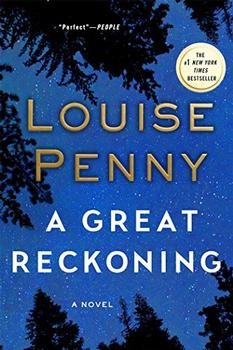Summary | Excerpt | Reviews | Beyond the book | Read-Alikes | Genres & Themes | Author Bio

I have a rule: I won't call a book a page-turner unless reading
it causes me to miss my bus stop. Engrossed in David Hewson's latest mystery,
The Garden of Evil, I missed my stop not once but twice – and that
was before I was halfway through the novel. This one's a page-turner all
right! It's also a top-notch, high-quality detective procedural that
will appeal to readers who enjoy a literary mystery.
The plot of The Garden of Evil revolves around a 17th-century painting by Caravaggio,
so understanding the artist's life and work is important to the overall plot.
Happily, Hewson provides a great deal of historical detail without lecturing.
In fact, the historical background is every bit as entertaining as the moments of suspense, and
is one of the features that make the book such a stand-out.
Setting his novel entirely in Rome, Hewson does a wonderful job of recreating
the city for his readers, allowing its atmosphere to permeate the book. His
readers not only "see" the city with their imagination, they "feel" the cold
stones of its streets and buildings and experience the claustrophobia of its
alleys as the detectives pursue their suspect.
"Thirty minutes later they stood on the stops of the Palazzo Malaspina. The entrance dominated much of the narrow seventeenth-century street that led, in a few short minutes, to the Mausoleum of Augustus, a place Costa had yet to find the courage to revisit…Everything about this case, it seemed to Costa, was contained in the small, secretive warren of dark, dingy alleys here, the labyrinth that was once Ortaccio."
Authors with the ability to create such vivid descriptions of
time and place sometimes fall short when it comes to writing action sequences.
Such is not the case with Hewson who delivers action that is both riveting and
cinematic. What truly draws the reader, though, are the sections of the novel
that concentrate on revelation – revelation of clues to solving the crime as
well as the illumination of the principals' characters. Some of the most
engaging sections of the book involve Da Vinci Code-like discoveries
about the mysterious Caravaggio painting. These disclosures are not as controversial as those in The Da Vinci Code, but readers will find them fascinating none the less.
Hewson manages the difficult feat of balancing a ripping good mystery with
high-quality writing. The Garden of Evil will unquestionably appeal to
long-time fans and is certain to attract new ones. Although the novel is the
sixth in a series featuring detective Nic Costa, for the most part the book
stands well on its own. The plot is independent of those in Hewson's earlier
novels; hence it is unnecessary to read the previous five to enjoy this one.
Having said that, readers new to the series may note a lack of up front
character description - presumably because the characters have been extensively
developed in earlier novels. Because of
this, those unfamiliar with the series may initially find it difficult to form a
connection to the main players. Another facet only hinted at is the complex
relationships that exist between members of the investigative team that have
obviously been developed in previous books. It's a bit like attending a
gathering where you know no one, but everyone else is friends - only gradually
do you
become aware of undercurrents of tension or affection that are already obvious
to everyone else in the room. However, the characters are sufficiently
compelling that even readers new to the series will have developed an affinity
for them by the end of the novel - and will come away believing their time has
been very well well spent.
About The Author & Series
Yorkshire-born, David Hewson did not travel abroad until he was 21. He was
born in 1953, left school when he was seventeen to work as a cub reporter on a
local newspaper and, eight years later was a staff reporter on the The Times in
London covering news, business and latterly working as arts correspondent. He
worked on the launch of the Independent and was a weekly columnist for
the Sunday Times for a decade before giving up journalism entirely in
2005 to focus on writing fiction.
After publishing five standalone novels, Hewson introduced Detective
Nic Costa of the Rome police force in A Season for the Dead (2003).
This was followed by The Villa of Mysteries, The Sacred Cut, The Lizard's Bite,
The Seventh Sacrament and The Garden of Evil. Lucky readers in the UK have been able to get their hands on the seventh in the series, Dante's Numbers, since 2007; it will publish in the USA in late March 2009.
Hewson spends a couple of months each year
in Italy, mostly in Rome, and lives the rest of the year on the top of the North
Downs in Kent, close to the village of Wye.
![]() This review was originally published in The BookBrowse Review in September 2008, and has been updated for the
February 2009 edition.
Click here to go to this issue.
This review was originally published in The BookBrowse Review in September 2008, and has been updated for the
February 2009 edition.
Click here to go to this issue.

If you liked The Garden of Evil, try these:

by Louise Penny
Published 2021
The 16th novel by #1 bestselling author Louise Penny finds Chief Inspector Armand Gamache of the Sûreté du Quebec investigating a sinister plot in the City of Light.

by Louise Penny
Published 2017
Winner of the 2016 BookBrowse Fiction Award
Bestselling author Louise Penny pulls back the layers to reveal a brilliant and emotionally powerful truth in her latest spellbinding novel.
Your guide toexceptional books
BookBrowse seeks out and recommends the best in contemporary fiction and nonfiction—books that not only engage and entertain but also deepen our understanding of ourselves and the world around us.